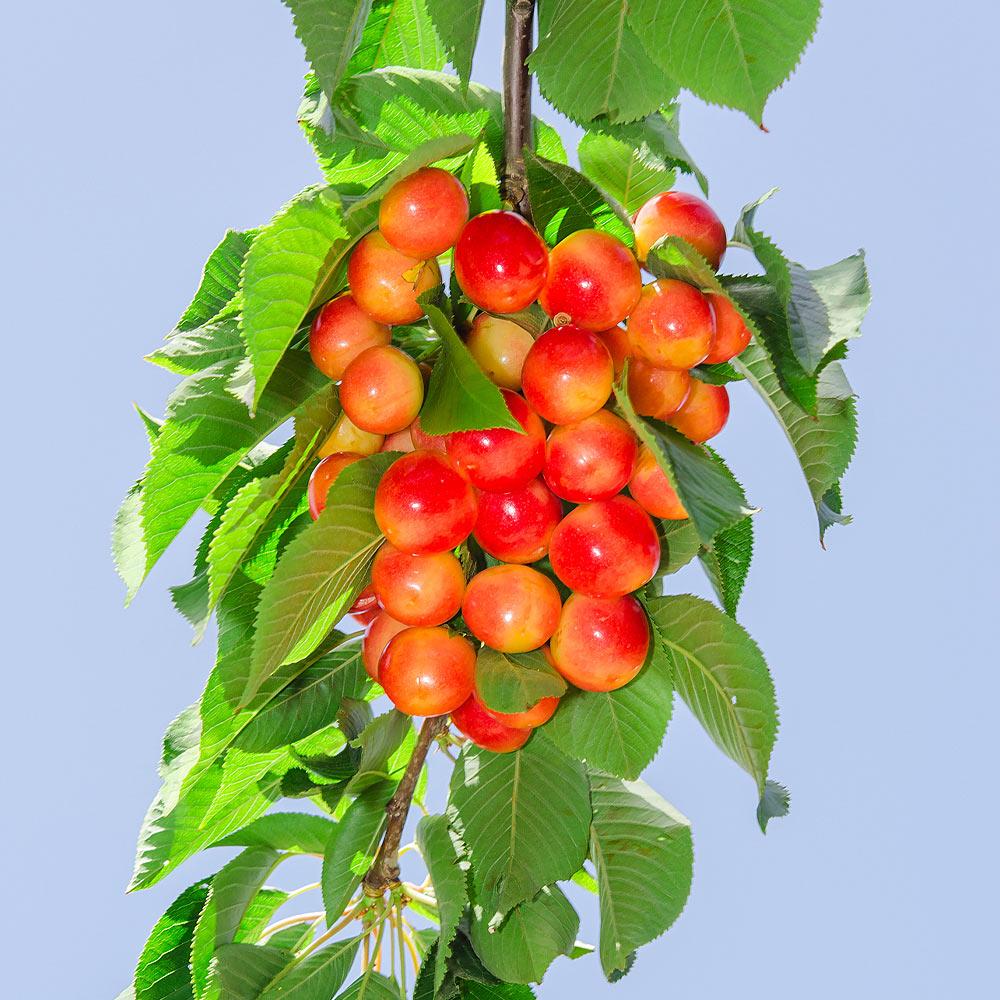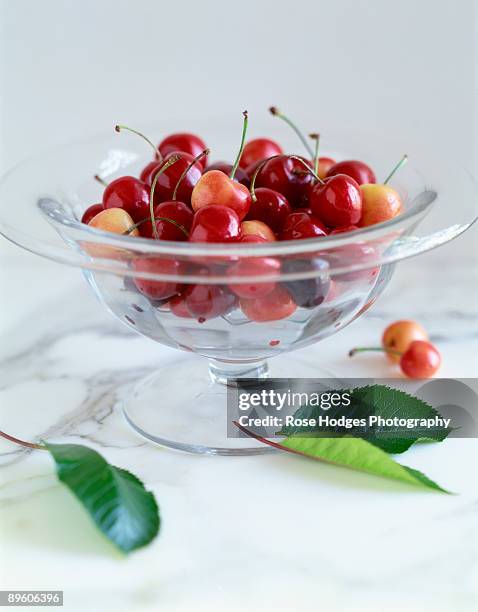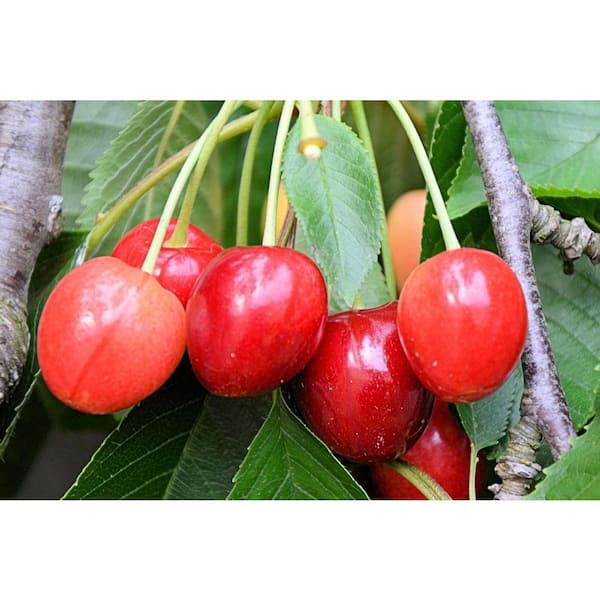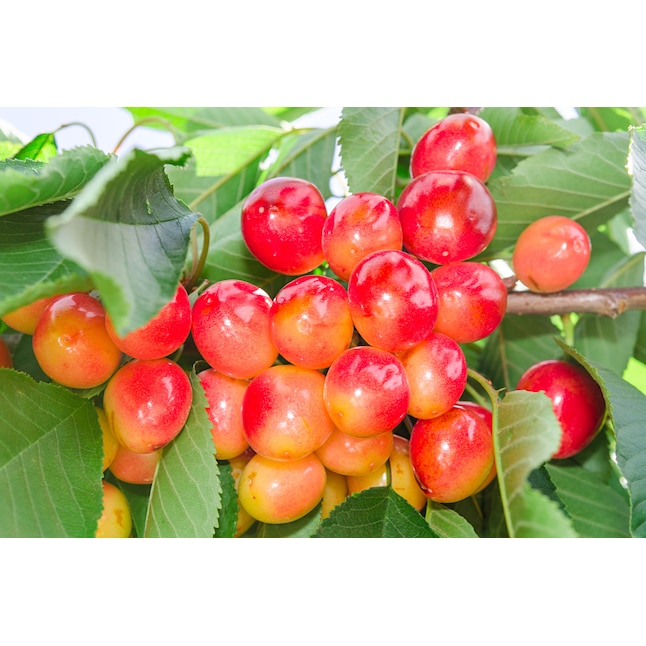Royal Ann Cherry Trees for Sale

Dominating in taste and all-around appeal, the Royal Ann Cherry Tree will rule your garden! Order yours to add its refreshing cherries to baked goods, jams, drinks and more.
Sweet Cherries To Rule The Garden
Cultivated from sweet wild cherries, the Royal Ann Cherry Tree will treat your senses! There’s nothing like homegrown fruit, and this variety will provide the juiciest flavor boost and the most refreshing snack.
This semi-dwarf cherry tree might be smaller in size, but it was born to produce, and without being high maintenance. Notably, it’ll thrive in most soil types, while deterring pests and tolerating cooler temperatures down to -10 degrees!
With a refreshing and crisp texture and a firm flesh prized for commercial and home canning, you can expect a delicacy of cherry bounties full of flavor, plump and juicy. Our mouths are already watering!
Enjoy your Royal Ann Cherries straight off the tree, in baked goods and recipes, dried or canned—the options are limitless! They're often incorporated in pies, grilling sauces, jams and preserves and are a favored choice for maraschino cherries, making them the perfect topper for fun drinks and cocktails.
Dominating in taste and all-around appeal, the Royal Ann Cherry Tree will rule your garden!
Planting & Care
1. Planting: Choose a sunny spot that will give your cherry tree a minimum of 6 hours of direct sunlight per day. Although it will thrive in almost any kind of soil, avoid locations where the soil will remain soggy for prolonged lengths of time.
Dig a hole that is as deep as the root ball and three times as wide. Place the roots in the hole and fill the hole about half-way with soil, tamp to remove air pockets then fill the hole completely. Spread a layer of mulch over the soil around your cherry tree to help keep the soil moist, encourage healthy growth and protect your tree against competing growth.
2. Watering: During the growing season, if your tree receives at least an inch of rain every 10 days, then no additional irrigation is necessary. If the season is hot and dry then you may need to provide some additional water. The best way to water is by using a slow trickling garden hose left at the base of the tree. This will allow the water to penetrate the soil more deeply and prevent it from running off over the soil surface. Make sure the ground is fully moisturized all around the root system.
3. Pruning: A year after planting your Royal Ann, prune your tree in the late to end of winter while dormant. Shape the tree to encourage horizontal branch growth with space between branches. Prune once a year as necessary to remove weak, drooping branches.
4. Fertilizing: Good, nutrient-rich soil should only require the addition of nitrogen. Fertilize in the spring and midsummer using nitrogen fertilizer twice annually applying 2 weeks after planting and 4 weeks after the first application. Use a complete fertilizer such as 10-10-10 and apply at the rate of 0.05 pounds of actual nitrogen per dose. Fertilizer application ratios vary upon the formulation so be sure to follow package directions.
Sweet Cherries To Rule The Garden
Cultivated from sweet wild cherries, the Royal Ann Cherry Tree will treat your senses! There’s nothing like homegrown fruit, and this variety will provide the juiciest flavor boost and the most refreshing snack.
This semi-dwarf cherry tree might be smaller in size, but it was born to produce, and without being high maintenance. Notably, it’ll thrive in most soil types, while deterring pests and tolerating cooler temperatures down to -10 degrees!
With a refreshing and crisp texture and a firm flesh prized for commercial and home canning, you can expect a delicacy of cherry bounties full of flavor, plump and juicy. Our mouths are already watering!
Enjoy your Royal Ann Cherries straight off the tree, in baked goods and recipes, dried or canned—the options are limitless! They're often incorporated in pies, grilling sauces, jams and preserves and are a favored choice for maraschino cherries, making them the perfect topper for fun drinks and cocktails.
Dominating in taste and all-around appeal, the Royal Ann Cherry Tree will rule your garden!
Planting & Care
1. Planting: Choose a sunny spot that will give your cherry tree a minimum of 6 hours of direct sunlight per day. Although it will thrive in almost any kind of soil, avoid locations where the soil will remain soggy for prolonged lengths of time.
Dig a hole that is as deep as the root ball and three times as wide. Place the roots in the hole and fill the hole about half-way with soil, tamp to remove air pockets then fill the hole completely. Spread a layer of mulch over the soil around your cherry tree to help keep the soil moist, encourage healthy growth and protect your tree against competing growth.
2. Watering: During the growing season, if your tree receives at least an inch of rain every 10 days, then no additional irrigation is necessary. If the season is hot and dry then you may need to provide some additional water. The best way to water is by using a slow trickling garden hose left at the base of the tree. This will allow the water to penetrate the soil more deeply and prevent it from running off over the soil surface. Make sure the ground is fully moisturized all around the root system.
3. Pruning: A year after planting your Royal Ann, prune your tree in the late to end of winter while dormant. Shape the tree to encourage horizontal branch growth with space between branches. Prune once a year as necessary to remove weak, drooping branches.
4. Fertilizing: Good, nutrient-rich soil should only require the addition of nitrogen. Fertilize in the spring and midsummer using nitrogen fertilizer twice annually applying 2 weeks after planting and 4 weeks after the first application. Use a complete fertilizer such as 10-10-10 and apply at the rate of 0.05 pounds of actual nitrogen per dose. Fertilizer application ratios vary upon the formulation so be sure to follow package directions.
Dwarf Tree Produces Bushels of Cherries It takes only a small space in your backyard garden, but our Dwarf Bing Cherry Tree makes a big statement. Bing Cherries require little care maintenance yet produce many pounds of fruit each season. And Dwarf Bing Cherry Trees produce fruit earlier than standard Cherry Trees, so you can enjoy the fruits of your labor even faster! Best of all, Bing Cherries are the most popular cherries found in supermarkets since they're famous for their sweet, robust and juicy taste. They also last for quite a long time, when stored properly. But the top benefit of our Bing Cherry Tree is its amazing beginning. Because we've grafted and grown our Bing Cherry from proven, consistent rootstock, you get amazing results in your homescape. You get faster, fresher fruit and delicious home-grown taste since we've nurtured our Bing Cherry Tree long before it arrives at your door. And though our Dwarf Bing Cherry Tree requires pollinating (we recommend the Black Tartarian Cherry Tree for best results), planting is easy and you get bushels upon bushels of cherries as a result. These cherries are delicious, nutritious and easy to grow. So, no matter where you plant it, the Bing Cherry Tree is a must-have - order your own Bing Cherry today! Planting & Care 1. Planting: Select an area with well-drained soil and full sun (6 to 8 hours of sunlight per day). Once you've selected your location, dig a hole that's approximately a foot and a half deep and equally as wide for your tree. Place your Bing Cherry in the hole, tamp down the surrounding soil, and then water to settle the roots. Finally, spread a layer of mulch over the soil to encourage healthy growth and preserve moisture. 2. Watering: During the growing season, if your tree receives at least an inch of rain every 10 days, no additional irrigation is necessary. If the season is hot and dry, however, you may need to provide some additional water. The best way to water is by using a slow trickling garden hose and leaving it at the base of the tree for about 30 seconds - do this once a week. If you're not sure when to water, however, check the soil about 2 or 3 inches down with your index finger. If the soil is dry in this area, it's time to water. 3. Pruning: A year after planting your Bing, prune in the late winter, while it's still dormant. Shape the tree to encourage horizontal branch growth with space between branches, and prune once a year as necessary to remove weak, drooping branches. 4. Fertilizing: Fertilize in the spring and midsummer using nitrogen fertilizer, ensuring you apply 2 weeks after planting and 4 weeks after the first application. Use a complete fertilizer, like 10-10-10, and apply 6 to 8 inches away from the trunk. BB Tip: Surround your Cherry Tree with a thin layer of mulch each spring to preserve moisture, and avoid organic fertilizers for best results.

Royal Ann Dave Wilson Nursery, 57% OFF

Tips For Growing Winter Pansies (Viola Hiemalis) Gardener's, 49% OFF

Royal Ann Cherry

Royal Ann Cherry Trees for Sale

cdn.shopify.com/s/files/1/0059/8835/2052/products/

Royal Ann Dave Wilson Nursery, 57% OFF

Tips For Growing Winter Pansies (Viola Hiemalis) Gardener's, 49% OFF

Royal Ann Dave Wilson Nursery, 57% OFF

cdn.shopify.com/s/files/1/0059/8835/2052/files/Ste

Royal Ann Dave Wilson Nursery, 57% OFF







